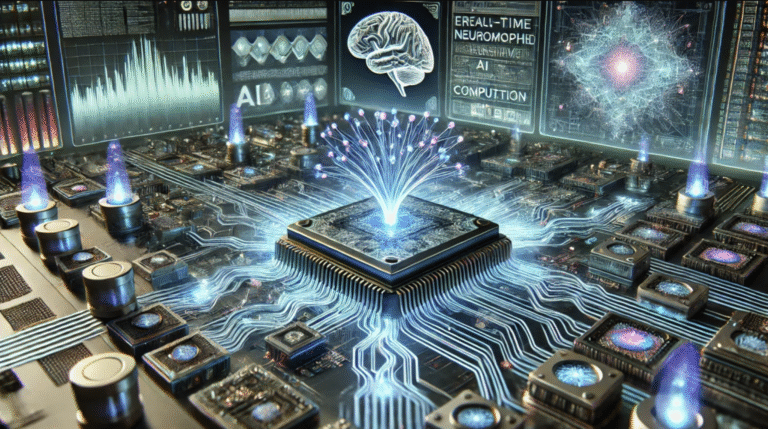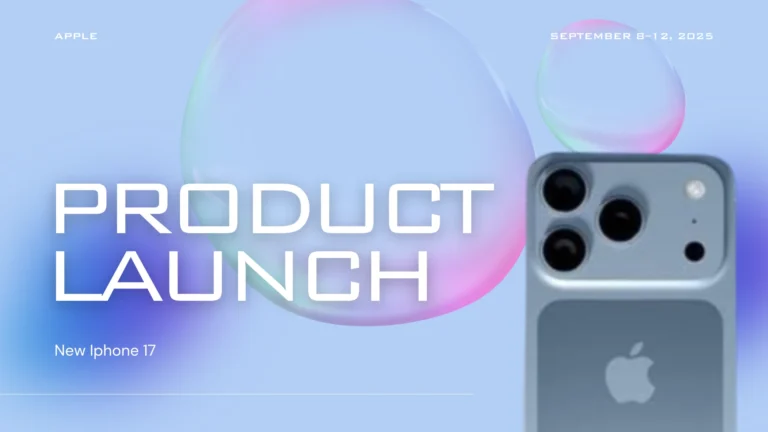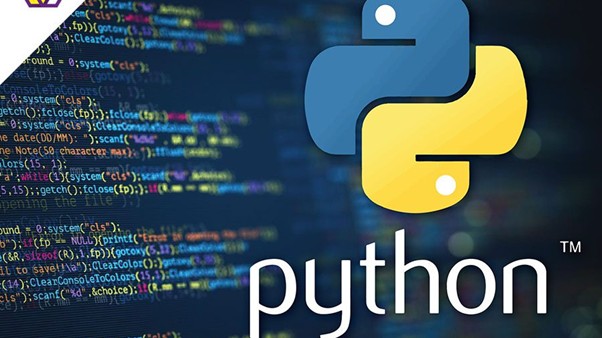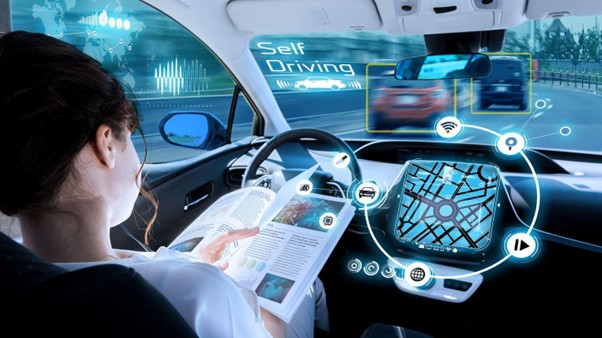As the world continues to harness the capabilities of 5G, the telecommunications industry is already setting its sights on the next generation: 6G. Envisioned to be operational by 2030, 6G promises to revolutionize connectivity with ultra-low latency, unprecedented data speeds, and intelligent network management. This evolution is not merely an incremental upgrade but a transformative leap that will redefine various sectors, including autonomous vehicles and remote healthcare.
Terahertz Communication: Pushing the Boundaries

The advent of sixth generation (6G) wireless networks aims to achieve unprecedented data rates and ultra-low latency, with targets of up to 1 terabit per second (Tbps) and latency as low as 0.1 milliseconds. To realize these objectives, 6G leverages the terahertz (THz) frequency band, spanning from 0.1 to 10 THz [1]. However, THz communication faces significant challenges, including high propagation losses and atmospheric absorption. To mitigate these issues, advanced modulation schemes like Orthogonal Time Frequency Space (OTFS) are being explored. OTFS operates in the delay-Doppler domain, providing resilience against channel variations and Doppler effects, making it suitable for high-mobility scenarios such as vehicular communications and unmanned aerial vehicles [2].

Complementing OTFS, beamforming techniques are crucial for directing THz signals efficiently. Recent developments include on-chip terahertz beamforming using photonic topological insulators, enabling precise control of signal directionality and enhancing link reliability. Additionally, ultra-massive multiple-input multiple-output (UM-MIMO) systems are being designed to compensate for the high path loss inherent in THz frequencies [2].
Artificial Intelligence (AI) integration is fundamental to the 6G vision, facilitating intelligent network management and optimization. Deep Reinforcement Learning (DRL) algorithms are employed for dynamic resource allocation and network slicing, adapting to real-time network conditions [3]. Federated Learning (FL) enables decentralized model training across devices, preserving data privacy and reducing communication overhead. Graph Neural Networks (GNNs) are utilized to model complex network topologies, enhancing tasks such as routing and anomaly detection [3].
Applications: Transforming Industries
Autonomous Vehicles

In the domain of intelligent transportation, 6G networks are poised to radically enhance Connected and Autonomous Vehicles (CAVs). The CAV ecosystem integrates critical functions like sensing, communication, computation, and positioning through the fusion of technologies such as Terahertz (THz) bands, mmWave, Mobile Edge Computing (MEC), and AI/ML algorithms [4].
At the network layer, Vehicle-to-Everything (V2X) communication—comprising V2V, V2I, and V2P protocols—facilitates real-time bidirectional data exchange [5]. This is powered by Ultra-Reliable Low-Latency Communication (URLLC) protocols and massive MIMO antennas, ensuring throughput requirements of over 1 Tbps and latency under 1 ms [6].
In CAV systems, Edge Computing Nodes collocated at Roadside Units (RSUs) and Base Stations enable distributed computation using containerized microservices and AI-based scheduling algorithms like Proximal Policy Optimization (PPO) or Trust Region Policy Optimization (TRPO) for task offloading [4]. Algorithms such as Kalman Filters assist in localization and path prediction, while Monte Carlo Tree Search (MCTS) is applied in real-time decision-making for ADAS modules.
Remote Healthcare
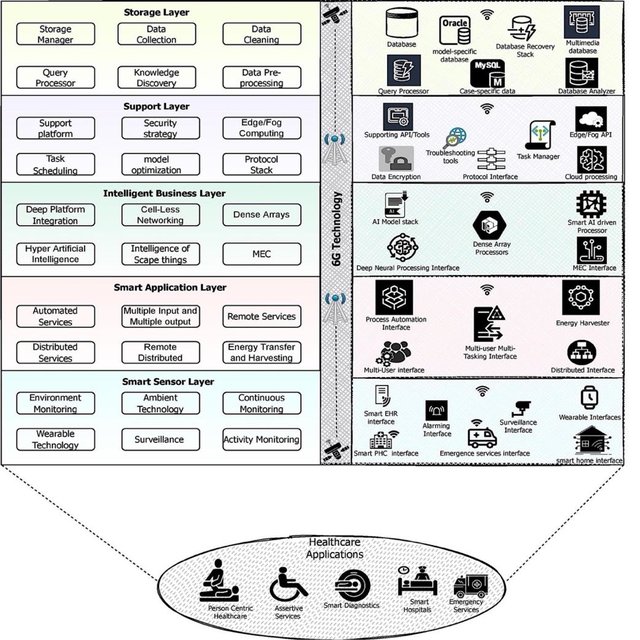
One of the most transformative applications of 6G lies in the healthcare sector, where ultra-reliable, low-latency communication and high-throughput data handling are mission-critical. 6G enables an advanced, multi-layered architecture that supports real-time, intelligent, and immersive medical services, especially in scenarios like remote surgeries, chronic patient monitoring, and emergency response.
A Multi-Layered 6G Healthcare Framework
This application is structured into five interdependent technological layers, each contributing to robust medical service delivery:
- Smart Sensor Layer: Wearable biosensors, embedded IoT medical devices, and implantable nodes monitor physiological signals in real-time. These devices communicate over energy-efficient protocols such as 6LoWPAN and Bluetooth Low Energy (BLE), enabling ultra-low power operation in pervasive environments [8].
- Smart Application Layer: Medical data is transmitted via Massive MIMO systems for spectral efficiency, while Harvest-Store-Use (HSU) energy models ensure sustainable device operation. This layer supports telehealth services, real-time alerts, and continuous telemetry for chronic care [8].
- Intelligent Business Layer: At this level, Cell-Bus Networking and Dense Array topologies facilitate scalable bandwidth management and simultaneous data flows. Multi-access Edge Computing (MEC) nodes use AI algorithms such as Convolutional Neural Networks (CNNs) for image diagnostics and Recurrent Neural Networks (RNNs) for time-series physiological data inference [8].
- Support Layer: Computational tasks are distributed through Edge–Fog computing using orchestrators like Kubernetes, OpenFaaS, or Knative, which enable event-driven, containerized service delivery for scalable healthcare microservices [8].
- Storage Layer: Data is streamed and cleaned using Apache Kafka, then pre-processed for model training or anomaly detection, and stored in NoSQL databases such as MongoDB or Cassandra. These systems support federated retraining of diagnostic models without centralizing sensitive patient data [8].
Together, these integrated layers enable applications such as robot-assisted telesurgery, AI-aided diagnostics, emergency triaging with haptic feedback, and interactive rehabilitation using tactile internet interfaces—all core use cases empowered by the high bandwidth and low latency of 6G networks.
Challenges and Considerations

- Infrastructure Development:
6G demands ultra-dense deployments of base stations, THz transceivers, and edge nodes. Technologies like Ultra-Massive MIMO (UM-MIMO) and Reconfigurable Intelligent Surfaces (RIS), essential for beamforming in THz links, require precise placement and high CAPEX [9]. Integrating Tera-WiFi, Tera-IAB, and Tera-SpaceCom infrastructures—such as two-hop THz backhaul and air-land gateways—necessitates a multi-layered hybrid network fabric [10].
- Spectrum Allocation:
Allocating bands across 0.1–10 THz must account for atmospheric absorption, especially in the 0.275–0.3 THz region. Dynamic spectrum access using Deep Q-Learning and Markov Decision Processes (MDPs) is being investigated to enable real-time spectrum reuse, but global regulatory consensus remains unresolved [9].
- Security and Privacy:
6G introduces risks across data, control, and AI layers. Techniques such as Homomorphic Encryption for privacy-preserving ML, Blockchain-based identity authentication, and Federated Adversarial Training (FAT) for intrusion detection are proposed. However, these increase processing overhead, challenging resource-constrained edge devices [10].
- Standardization:
Harmonizing across global bodies like ITU, 3GPP, and IEEE is essential for Tera-IoT and space-terrestrial integration [9]. Protocol unification must include support for Time-Sensitive Networking (TSN), Zero Trust Architectures, and AI-Native Service Function Chaining (SFC) to ensure real-time, secure interoperability across domains [10].
References
[1] Z. Chen et al., “Terahertz wireless communications for 2030 and beyond: A cutting-edge frontier,” IEEE Commun. Mag., vol. 59, no. 11, pp. 66–72, 2021.
[2] W. Yuan et al., “New delay Doppler communication paradigm in 6G era: A survey of orthogonal time frequency space (OTFS),” China Commun., vol. 20, no. 6, pp. 1–25, 2023.
[3] Q. Cui et al., “Overview of AI and communication for 6G network: Fundamentals, challenges, and future research opportunities,” arXiv [cs.NI], 2024.
[4] S. A. Abdel Hakeem, H. H. Hussein, and H. Kim, “Vision and research directions of 6G technologies and applications,” J. King Saud Univ. – Comput. Inf. Sci., vol. 34, no. 6, pp. 2419–2442, 2022.
[5] M. Hasan, S. Mohan, T. Shimizu, and H. Lu, “Securing vehicle-to-everything (V2X) communication platforms,” IEEE Trans. Intell. Veh., vol. 5, no. 4, pp. 693–713, 2020.
[6] P. Popovski et al., “Wireless access in ultra-reliable low-latency communication (URLLC),” IEEE Trans. Commun., vol. 67, no. 8, pp. 5783–5801, 2019.
[7] K. B. Letaief, W. Chen, Y. Shi, J. Zhang, and Y.-J. A. Zhang, “The roadmap to 6G — AI empowered wireless networks,” arXiv [cs.NI], 2019.
[8] P. N. Srinivasu, M. F. Ijaz, J. Shafi, M. Wozniak, and R. Sujatha, “6G driven fast computational networking framework for healthcare applications,” IEEE Access, vol. 10, no. 99, pp. 94235–94248, 2022.
[9] C. Han, Y. Wu, Z. Chen, and X. Wang, “Terahertz communications (TeraCom): Challenges and impact on 6G wireless systems,” arXiv [eess.SP], 2019.
[10] H. Tataria, M. Shafi, A. F. Molisch, M. Dohler, H. Sjöland, and F. Tufvesson, “6G wireless systems: Vision, requirements, challenges, insights, and opportunities,” Proc. IEEE Inst. Electr. Electron. Eng., vol. 109, no. 7, pp. 1166–1199, 2021


